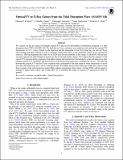Optical/UV-to-X-Ray Echoes from the Tidal Disruption Flare ASASSN-14li
Author(s)
Cenko, S. Bradley; Guillochon, James; Stone, Nicholas C.; Velzen, Sjoert van; Cannizzo, John K.; Pasham, Dheeraj Ranga Reddy; Sadowski, Aleksander B; ... Show more Show less
DownloadPasham-2017-Optical_UV-to-X-Ray Echoes from th.pdf (1.529Mb)
PUBLISHER_POLICY
Publisher Policy
Article is made available in accordance with the publisher's policy and may be subject to US copyright law. Please refer to the publisher's site for terms of use.
Terms of use
Metadata
Show full item recordAbstract
We carried out the first multi-wavelength (optical/UV and X-ray) photometric reverberation mapping of a tidal disruption flare (TDF) ASASSN-14li. We find that its X-ray variations are correlated with and lag the optical/UV fluctuations by 32 ± 4 days. Based on the direction and the magnitude of the X-ray time lag, we rule out X-ray reprocessing and direct emission from a standard circular thin disk as the dominant source of its optical/UV emission. The lag magnitude also rules out an AGN disk-driven instability as the origin of ASASSN-14li and thus strongly supports the tidal disruption picture for this event and similar objects. We suggest that the majority of the optical/UV emission likely originates from debris stream self-interactions. Perturbations at the self-interaction sites produce optical/UV variability and travel down to the black hole where they modulate the X-rays. The time lag between the optical/UV and the X-rays variations thus correspond to the time taken by these fluctuations to travel from the self-interaction site to close to the black hole. We further discuss these time lags within the context of the three variants of the self-interaction model. High-cadence monitoring observations of future TDFs will be sensitive enough to detect these echoes and would allow us to establish the origin of optical/UV emission in TDFs in general.
Date issued
2017-03Department
MIT Kavli Institute for Astrophysics and Space ResearchJournal
The Astrophysical Journal Letters
Publisher
IOP Publishing
Citation
Pasham, Dheeraj R. et al. “Optical/UV-to-X-Ray Echoes from the Tidal Disruption Flare ASASSN-14li.” The Astrophysical Journal 837.2 (2017): L30. © 2017 The American Astronomical Society
Version: Final published version
ISSN
2041-8213
2041-8205